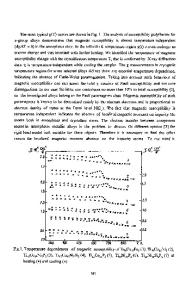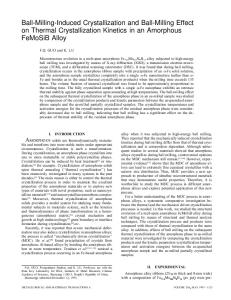Thermal Stability and Crystallization Kinetics in Y-Based Metallic Glasses
- PDF / 481,401 Bytes
- 7 Pages / 593.972 x 792 pts Page_size
- 14 Downloads / 321 Views
UCTION
SINCE Duwez discovered the Au-Si metallic glass in the 1960s,[1] extensive experimental and theoretical efforts have been undertaken to study the glass-forming ability (GFA) of metallic alloy systems.[2–7] Up until now, the rare-earth (RE)–based metallic glasses, which have the potential for application as functional materials, have been found in many alloy systems, such as Labased,[8] Nd-based,[9] Ce-based,[10] and Pr-based.[11] A new family of Y-based bulk metallic glasses (BMGs) was synthesized in 2003 by a water-quenching method.[12] Guo et al.[12] pointed out that the GFA of Y-AlCo alloys near Y56Al24Co20 (at. pct) composition is very high. By replacing Y with 20 at. pct Sc for Y56Al24Co20 metallic glass, an ingot of a critical diameter of 20 mm can be obtained by water quenching.[12] However, little is known about the thermal stability and crystallization kinetics of Y-based BMGs. Previous theoretical studies predicted that the thermal stability of metallic glasses would be enhanced with the high bulk modulus of the base component.[7] Li et al.[13] have proved that heavy RE-based BMGs have high glass transition and crystallization temperatures and thermal stability, due to the relatively higher elastic Dr. SHIWEN HE, YONG LIU and BAIYUN HUANG, Professors, Drs. ZHANTAO LI, and HONG WU are with the State Key Laboratory of Powder Metallurgy, Central South University, Changsha, 410083, Hunan, PeopleÕs Republic of China. Contact e-mail: yonliu11@ yahoo.com.cn This article is based on a presentation given in the symposium entitled ‘‘Bulk Metallic Glasses IV,’’ which occurred February 25– March 1, 2007 during the TMS Annual Meeting in Orlando, FL, under the auspices of the TMS/ASM Mechanical Behavior of Materials Committee. Article published online November 10, 2007 METALLURGICAL AND MATERIALS TRANSACTIONS A
constants in RE elements. As a heavy RE, Y has a relatively high bulk modulus (41 GPa) and melting point (Tm = 1799 K). Thereby, Y-based metallic glasses might exhibit relatively high thermal stability, if an amorphous structure can be formed. Moreover, Sc has a higher melting temperature (Tm = 1812 K) and a higher bulk modulus (57 GPa) than Y.[14] Furthermore, Sc (the radius of Sc is 0.164 nm) was introduced into the Y56Al24Co20 alloy to replace some Y, which still maintains the atomic size ratio principle. Therefore, the substitution of Y with a small amount of Sc may be an effective way to improve the thermal stability of the BMG and to improve the GFA of the previous alloy. The melt-spinning technique is commonly used to fabricate metallic glasses. First, it is cost-effective and only small amounts of high-purity metals are needed. Second, it has a much faster cooling rate than does the Cu-mold casting technique, thus leading to a more amorphous state. Furthermore, it is not as sensitive to processing parameters, such as impurities, temperature distribution, and inhomogeneous cooling, so the results of melt spinning should be more reliable. Thus, we first prepared Y56–xScxAl24Co20 (x = 0, 5, 10, 15, and 1
Data Loading...











